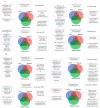Influence of Different Aggregation States on Volatile Organic Compounds Released by Dairy Kluyveromyces marxianus Strains
- PMID: 36141037
- PMCID: PMC9498923
- DOI: 10.3390/foods11182910
Influence of Different Aggregation States on Volatile Organic Compounds Released by Dairy Kluyveromyces marxianus Strains
Abstract
Kluyveromyces marxianus has the ability to contribute to the aroma profile of foods and beverages since it is able to produce several volatile organic compounds (VOCs). In this study, 8 dairy K. marxianus strains, previously selected for their adhesion properties, were tested for VOCs production when grown in different conditions: planktonic, biofilm-detached, and MATS forming-cells. It was shown that biofilm-detached cells were mainly able to produce higher alcohols (64.57 mg/L), while esters were mainly produced by planktonic and MATS forming-cells (117.86 and 94.90 mg/L, respectively). Moreover, K. marxianus biofilm-detached cells were able to produce VOCs with flavor and odor impacts, such as ketons, phenols, and terpenes, which were not produced by planktonic cells. In addition, specific unique compounds were associated to the different conditions tested. Biofilm-detached cells were characterized by the production of 9 unique compounds, while planktonic and MATS forming-cells by 7 and 12, respectively. The obtained results should be exploited to modulate the volatilome of foods and beverages and improve the production of certain compounds at the industrial level. Further studies will be carried out to better understand the genetic mechanisms underlying the metabolic pathways activated under different conditions.
Keywords: Kluyveromyves marxianus; MATS; biofilm; dairy products; volatile organic compounds.
Conflict of interest statement
The authors declare that they have no competing financial interest or personal relationships that could have appeared to influence the work reported in this paper. The funders had no role in the design of the study; in the collection, analyses, or interpretation of data; in the writing of the manuscript, or in the decision to publish the results.
Figures






Similar articles
-
Sniffing the wine differences: The role of Starmerella bacillaris biofilm-detached cells.Heliyon. 2024 Aug 3;10(15):e35692. doi: 10.1016/j.heliyon.2024.e35692. eCollection 2024 Aug 15. Heliyon. 2024. PMID: 39170400 Free PMC article.
-
Unlocking the potential of Kluyveromyces marxianus in the definition of aroma composition of cheeses.Front Microbiol. 2024 Sep 18;15:1464953. doi: 10.3389/fmicb.2024.1464953. eCollection 2024. Front Microbiol. 2024. PMID: 39360317 Free PMC article.
-
Chromosome arrangement, differentiation of growth kinetics and volatile molecule profiles in Kluyveromyces marxianus strains from Italian cheeses.Int J Food Microbiol. 2015 Dec 2;214:151-158. doi: 10.1016/j.ijfoodmicro.2015.08.001. Epub 2015 Aug 13. Int J Food Microbiol. 2015. PMID: 26310129
-
Cell factory applications of the yeast Kluyveromyces marxianus for the biotechnological production of natural flavour and fragrance molecules.Yeast. 2015 Jan;32(1):3-16. doi: 10.1002/yea.3054. Epub 2014 Dec 11. Yeast. 2015. PMID: 25393382 Review.
-
Bioprospecting Kluyveromyces marxianus as a Robust Host for Industrial Biotechnology.Front Bioeng Biotechnol. 2022 Apr 20;10:851768. doi: 10.3389/fbioe.2022.851768. eCollection 2022. Front Bioeng Biotechnol. 2022. PMID: 35519613 Free PMC article. Review.
Cited by
-
Sniffing the wine differences: The role of Starmerella bacillaris biofilm-detached cells.Heliyon. 2024 Aug 3;10(15):e35692. doi: 10.1016/j.heliyon.2024.e35692. eCollection 2024 Aug 15. Heliyon. 2024. PMID: 39170400 Free PMC article.
-
Unlocking the potential of Kluyveromyces marxianus in the definition of aroma composition of cheeses.Front Microbiol. 2024 Sep 18;15:1464953. doi: 10.3389/fmicb.2024.1464953. eCollection 2024. Front Microbiol. 2024. PMID: 39360317 Free PMC article.
References
-
- Varela J.A., Gethins L., Stanton C., Ross P., Morrissey J.P. Applications of Kluyveromyces marxianus in Biotechnology. In: Satyanarayana T., Kunze G., editors. Yeast Diversity in Human Welfare. Springer; Singapore: 2017. pp. 439–453.
Grants and funding
LinkOut - more resources
Full Text Sources

